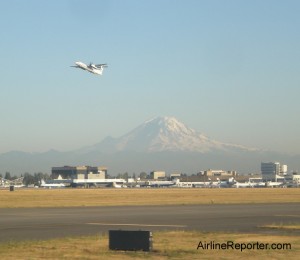
Why would you expect delays with nice weather like this seen in Seattle over the summer? Let's wait until winter DOT!
The Department of Transportation (DOT) is working with some funny math and concluding that the tarmac delay rule is working. Both Aubrey Cohen with the Seattle PI and Brett Snyder with CrankyFlier.com take a closer look at their math and don’t come to the same conclusions.
Instead of re-inventing the wheel, please read:
* DOT’s report, ’œLong Tarmac Delays in July Down Dramatically from Last Year’ that claims delays are down and cancellations have just a, “slight increase.”
* Snyder’s post, “DOT Continues to Claim Tarmac Delay Victory Despite 20 Percent Rise in Cancellations,” which shows how he doesn’t think a 20% increase in canceled flights is considered “slight.”
* Cohen’s article, “Cancellations inch up, or surge, thanks to tarmac rule,” takes a look how it might be a 20% rise, but when dealing with such small numbers, is it a big increase?
After taking a look at all three, I am not even close to admitting defeat (I am against the tarmac delay rule). It just started April 29th of this year and has only seen the summer. I am waiting to see what happens over the winter. Yes, I imagine delays will be down, but cancellations will be up — quite a bit. If I am wrong, I will more than happy eat my words, but I have a feeling there will be a lot of angry passengers this winter season.
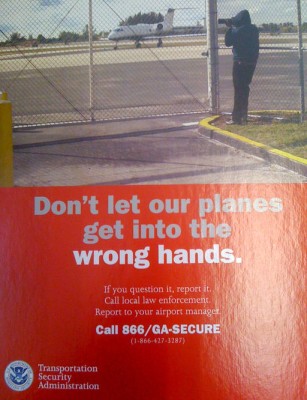
Make sure photographers don't steal planes!
When I saw this poster yesterday via Carlos Miller on Photography is Not a Crime, I thought it might have been fake. Making photographers look like bad people is a bad idea. It will cause more people to be fearful and waste the time of law enforcement officials. Yes, if you see someone by an airport doing something suspicious, report it. Taking photos of aircraft is not suspicious.
Every time I fly I am constantly taking photos. I used to use an HD camcorder, but decided to stop and use a standard digital camera. There have been multiple times I have received odd looks for taking photos using the camcorder and I even had a run-in with the TSA.
If you are a photographer and “get caught,” it might be a good time to inform them of your hobby. Drewski2112 shared on Airliners.net about his run-ins with the law plane spotting in Seattle. He once had five cars pull up on him at the same time. Instead of getting angry, he calmly explained what he was doing, shared his passion and by the time they left, some were asking for his website address to take a look at his photos. I only hope I could keep that calm and collective if I had five cop cars on me due to being a perceived security risk.
Unfortunatly this poster is not a fake, but it is very real. Knowing that many people were upset about the poster, the TSA confirmed on their blog yesterday. They tried to play it off that photographers are important for seeing suspicious activity, but I am not buying it. “In fact, many photographers would be prime candidates to use such vigilance programs to report suspicious activity since they’re extremely observant of their surroundings.” I am guessing this is more of an afterthought.
Photographers are not criminals and they should not be treated as such. If you do take airport-related photos, don’t let fear of law enforcement stop you, but be prepared. Have identification on you, know your local laws and try to talk to them with a smile and be proud of what you are doing. Oh and if you get some good airplane photos, email them on over to me and I would love to share them on the blog!
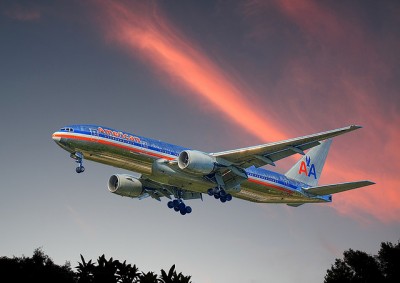
Wonderful shot of American Airlines Boeing 777-200ER
I hear from a lot of aviation enthusiasts, “why are people afraid of flying? It is the safest transportation out there.” I have heard all sorts of fascinating statistics on how much safer flying is than driving, but I wanted to check them out for myself and share what I found.
A lot of people feel they have a lack of control while flying. They are sitting in a seat 30,000 feet in the air and their life is in the hands of the pilot and luck. Many feel they have full control in their automobile and are able to avoid a deadly crash. Yes, there are many auto incidents that can be avoided, but in most fatal accidents, there is nothing the driver can do.
First, some raw information from government websites:
Data from NHTSA (2008):
Total Auto-Related: 34,017
Deaths to Drivers: 19,220
Deaths to Auto Passengers: 7,397
Pedestrian Deaths: 4,378
DATA FROM FRAOSA (2008):
Total Train Related Deaths: 800
Deaths on a train: 3
Ok you ready for this?
DATA FROM NTSB:
Deaths on 14 CFR 121 (Airlines)…
From 1982-Present: 2924
In 2009: 45
In 2008: 0
In 2007: 0
In 2006: 47
Deaths on 14 CFR 135 (Commuters)…
From 1982-Present: 364
In 2009: 0
In 2008: 0
In 2007: 0
In 2006: 1
The raw numbers are pretty interesting all on their own. I was hoping to compare 2008 stats with all transportation methods, but there just weren’t any airline-related fatalities in 2008. It is amazing that in 2008 34,017 Americans died in car related accidents, but in 28 years from 1982-2010 only 3,288 Americans have died from airline-related accidents. Just think about that… statistically, that means it would take over 117 years of airline fatalities to equal the same number of auto-related deaths just in 2008.
Although telling already, I also wanted to compare number of deaths per miles traveled by car versus airplane versus train. According to the Research and Innovative Technology Administration with the Bureau of Transportation Statistics, Americans in 2008 traveled 2,553,043,000,000 miles in cars, 583,506,000,000 miles via commercial aviation and 16,850,000,000 miles by rail. Doing the math, I looked at the number of deaths per 100 million miles traveled in the US:
TRAIN RELATED: 4.40
People being killed by a train in any fashion via FRAOSA
OTHER AUTO: 1.73
Motorcycles, pedestrians, auto related
AUTOS: 1.33
Only passenger vehicles
PASSENGER TRAIN: 0.13
People dying on the train via FRAOSA
COMMERCIAL AIRLINES: 0.0077
2009: 0.0077
2008: 0.0000
2007: 0.0000
Once again, it is hard to compare, since so many years for airlines have zero deaths. This means the average American is 190 times more likely to die in an auto accident in 2008 versus an automobile accident per 100 million miles traveled. So why do people concentrate so much on airline-related deaths versus others?
Well, the media and public really attach on to an airline crashing anywhere in the world. Heck, you normally will hear when an airline needs to make an emergency landing. However, you barely hear a peep about an auto-related death on the local news, let alone an auto death happening somewhere else in the nation or world. This slanted coverage gives passengers this false idea that airlines are inherently unsafe and people die all the time. Also, where an average of about 90 people die per day in a car related accident, they are spread through out the day and all over the country. It isn’t as shocking as 30-250 people dying at one time in an airline incident.
This just helps to reinforce how amazing air travel is in the US. What other transportation can you use in America today that is safer than that… other then not leaving your home? These are very complex machines, constantly flying as cheap as possible at all hours of the day. It truly is amazing more incidents don’t occur. Those that ask for the “good ‘ol days” of travel, should remember how much safer your flight is now than it was just 50 years ago.
On the other side of this, should airlines and airport continue to put millions of dollars into safety, when the industry is already very regulated and comparatively very safe? Is there such a thing as spending too much money to make air travel “too safe” or are the costs worth it?
Anyhow, getting off my soapbox, I know if you are afraid of flying, seeing these statistics probably isn’t going to help you feel too much at ease. However, next time you hit a bit of turbulence, think of how few people die each year flying and that there is a really, really really, really, really good chance you will be a.o.k!
Image: Luis Argerich
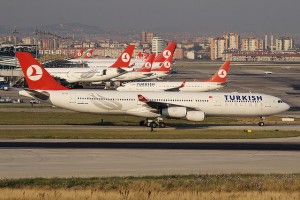
A nice Turkish Airlines Airbus A340 up front, lots of other Turkish planes in the background.
The argument for “passengers of size” has been going on for quite some time now. Now Turkish Airlines is looking to add “flight attendants of size” into the mix. 28 flight attendants have been put on unpaid leave to shape up or be reassigned.
Izzet Levi, head of a cabin attendants’ association, and one of those trying to lose weight, told the Haber Turk newspaper he must drop 22 pounds or he will get re-assigned.
This is a tricky situation. With larger passengers, it is easy just to have them purchase a second seat, but flight attendants need to be able to safely get up and down the aisle and help passengers get off the aircraft in case of an emergency.
It is easier with passengers to tell when they have to buy a second seat. If you can’t put your seatbelt on or put down the armrests, there is a good chance you will have to buy the seat next to you, but with flight attendants, it is not as easy.
Source: AOL Travel Image: Baris Karakaya
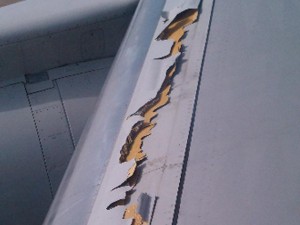
The rear of the slate is de-laminating on this American Airlines Boeing 757 on flight 1990.
Last Saturday American Airlines flight 1990 was about to take off from Miami to Orlando, when a passenger noticed a bit of damage to the wing’s right slat. As the flight of the Boeing 757 progressed the passenger, who wishes to remain anonymous, noticed the small damage had spread to the width of several feet and he notified one of the flight attendants.
WESH of Orlando spoke with American spokesperson, Tim Smith, and he confirmed that the Boeing 757 did have some de-lamination on the plane’s right wing. He stated the plane was taken out of service and ferried back to Miami to have repairs completed. Smith stated the de-lamination occurred on the rear of one of the wing’s slats, and even if the problem had affected the operation of the slat, the slats simply make the plane more aerodynamic but do not affect the plane’s ability to fly safely.
“I really do want to assure folks that safety wasn’t compromised and no one was in any danger because of this,” he said.
Some others aren’t so sure. Eric Norber of Orlando FAA Safety Team feels that the pilots should have made an emergency landing. At first glance this might look like a serious incident, but I am not so sure.
First off the flight from Miami to Orlando is extremely short and it might have taken longer for the pilot to make an emergency landing back in Miami versus continuing to Orlando. Obviously American felt it was not a safety risk, since the plane was flown back to Miami with no passengers aboard.
Ice or debris on the leading edge of slats can cause a loss of lift and serious issues, however the damage was on the rear of the slats and appears to be mostly cosmetic. While the rear of the slat is make of laminated composite material, the front part is made of alloy and the damage would not been able to spread.
That being said, I will continue to find out more information about this incident, but on the most part, this might just be a non-incident (except for a few interesting photos).
Someone on Airliners.net also posted a very cool image showing how the rear of the slat (this photo is of a Boeing 747, but still similar construction) is to the front.
Thanks Chris S for pointing this story out!
Image: WESH




